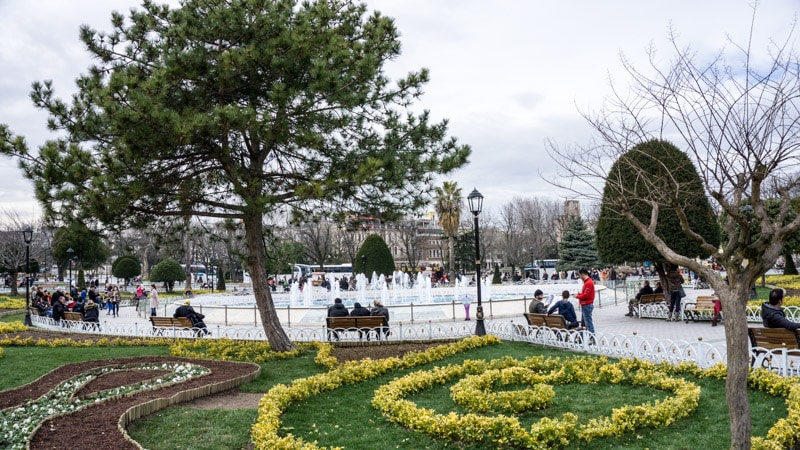
If you only have a few days in Istanbul, or even one, and are wondering what to do, the historic core walk is your best bet. Sultanahmet, the center of old Istanbul, is home to many of the city’s must-see sites, including the Blue Mosque, Hagia Sophia, Basilica Cistern, and the Hippodrome.
The walk begins at the park between the Blue Mosque and Hagia Sophia, not far from the Sultanahmet tram stop. You are now standing in the heart of the…
Table of Contents
Sultanahmet District
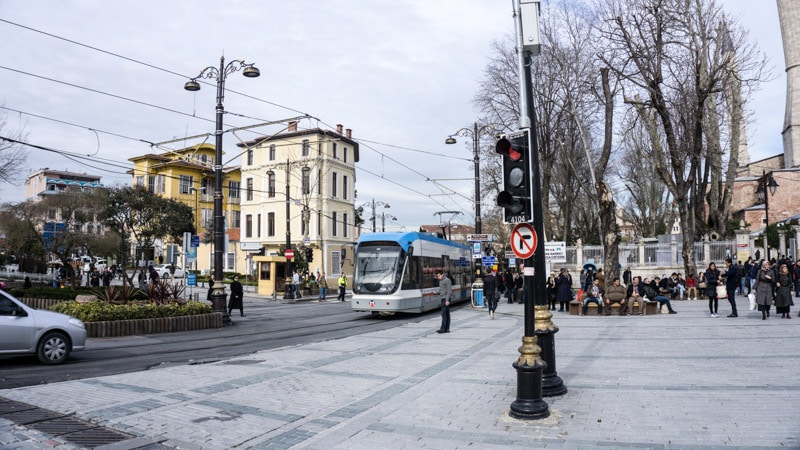
The Sultanahmet District is central to Istanbul’s historic core. The city’s old town sits on seven hills, with Sultanahmet on the first hill.
Greek settlers founded the city of Byzantium here. They prized the city’s strategic location, surrounded by water on three sides.
Today, Sultanahmet is popular with tourists who flock here for many world-class sites, including the Blue Mosque, Hagia Sophia, Basilica Cistern, and Hippodrome. If you are hungry for fantastic Turkish food, stop by one of the many restaurants in the area.
To understand the area, walk to Sultanahmet Park between the Blue Mosque and Hagia Sophia and sit on one of the benches.
You can take in all the sights, sounds, and people from here. The views of Blue Mosque and Hagia Sophia from this spot are stunning. This area is usually busy with locals, tourists, dogs, and cats all hours of the day.
From the water fountain at Sultanahmet Park, cross the small road and enter the beautiful…
Hagia Sophia
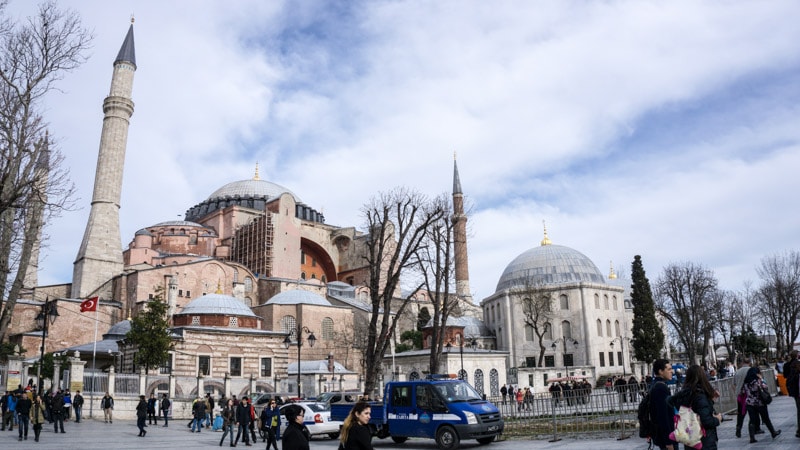
Even with the current construction, the Hagia Sophia is one of the world’s most unique, beautiful, and historic buildings. Over the years, Hagia Sophia has changed from a church to a mosque, then to a museum, and back to a mosque.
Hagia Sophia dates back to 532, during Emperor Justinian’s Golden Age. Completing the structure, which at the time seemed impossible, took over 5,000 workers and five years.
The magnificent building and the giant dome are undoubtedly the most significant architectural achievements of the Byzantine Empire.
For over 900 years, the church, also known as Megalo Ekklesia (Great Church), served as the seat of the Orthodox Patriarch of Constantinople.
It was not until 1453 that the church fell to the Ottomans and Sultan Mehmet. Impressed with the beauty of the building, Mehmet converted the church into a mosque. The church was converted into a mosque the day Constantinople fell.
For over 500 years, the mosque was the most important in Istanbul. Much of what you see today dates back to when Hagia Sophia initially served as a mosque. Most of the decorations that decorated the church are gone.
In 1934, the mosque became a museum.
Words cannot describe how small I felt the first time I walked inside Hagia Sophia. Even my camera could not take in all the beauty of the building, which is truly a marvel of man’s ingenuity. The well-preserved Hagia Sophia remains a reminder of the city’s history from the Byzantine Empire to the Ottoman Empire.
When you exit the Hagia Sophia, make an immediate right. Cross the first street (watch out for trams) and continue to reach the red and white striped entrance on the left to the…
Underground Basilica Cistern
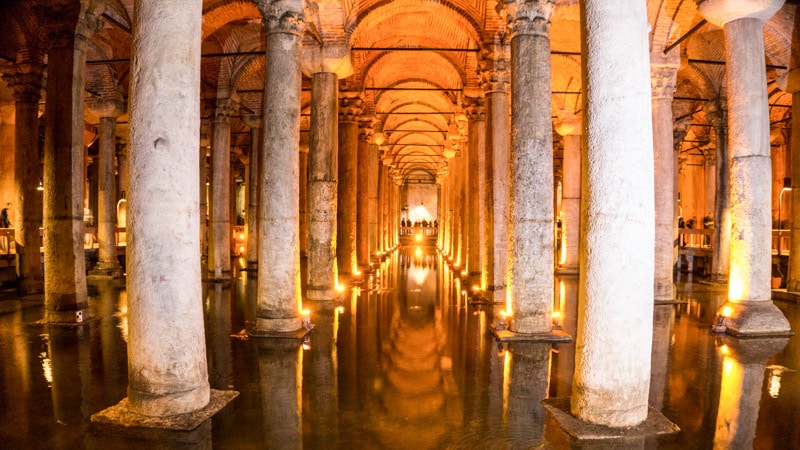
If you fear the dark, the underground Basilica Cistern might not be the best place to visit. Those not afraid of the dark or getting a little bit wet will enjoy the unique and dark experience underneath the city of Istanbul.
After you buy your ticket, carefully walk down the slippery stairs into the cistern.
This vast, dark, and damp underground reservoir dates back to the sixth-century Byzantine Empire during the rule of Emperor Justinian. The cistern gets its name from the basilica that once stood at this location years before.
During Justinian’s rule, the empire and Constantinople enjoyed a Golden Age. With Constantinople growing so fast, the water demand increased. The cistern, the largest reservoir in the city at the time, was built to keep up with this demand. The reservoir can hold about 27 million gallons of fresh water.
The columns you see in front of you, 336 in total, are used to support the brick ceiling above you, with many recycled from Roman ruins.
Thanks to a walkway, you can walk around almost the entire reservoir. Before the walkway and lights existed, the cistern was pitch black and only accessible by boat. Watch out for dripping water as you work your way around.
From the exit of the cistern, make a right and retrace your steps back to Sultanahmet Park. On the opposite side of the park is the towering…
Blue Mosque (Sultan Ahmed Mosque)
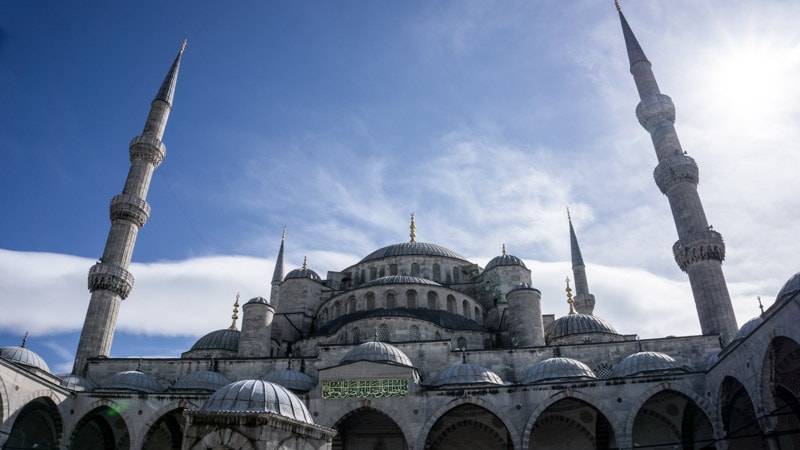
The Blue Mosque, also known as the Sultan Ahmed Mosque, is one of the world’s most famous and beautiful mosques.
When I first arrived in Istanbul, I took the tram from the airport to the Sultanahmet. Immediately exiting the tram station, I was a little disoriented and lost.
As I crossed the street, I saw the Blue Mosque for the first time. I stood there momentarily and stared in disbelief at how big and magnificent the mosque was, especially when lit at night.
The mosque took only seven years to construct, from 1609 to 1616. Though mosques only required one minaret for the imam (prayer leader), the Blue Mosque had six. The affluent sultan built six minarets to show off his wealth.
If you are a tourist, you must enter the mosque to the right of the inner courtyard during visiting hours.
The Blue Mosque’s visiting hours are 8:30 AM to 11:30 AM, 1:00 PM to 3:00 PM, and 4:00 PM to 5:00 PM.
There is usually a line of tourists waiting to enter, but the line moves quickly. It is free to enter the mosque.
If you wish to enter the mosque, I recommend you dress modestly. You should not wear shorts that show your knees, and women should cover their shoulders and heads with a scarf. You can borrow one at the entrance if you don’t have one.
Everyone who enters must remove their shoes, thanks to the carpeted floors.
When you walk inside, take a moment to admire the beauty of the interior, which includes all the handmade ceramic blue tiles. You will now understand why they call it the Blue Mosque. The massive dome above you, modeled after the one at Hagia Sophia, is 141 feet high and 110 feet in diameter. Looking at the structure’s corners, you will notice four giant marble pillars. These pillars support most of the weight of the building and allow for the many domes and the vast indoor space of the mosque.
Most of the prayers are in Arabic. If you arrive at the right time, you might be able to hear the imam speaking in English or catch him talking to tourists who have questions about Islam or the mosque.
Once you exit the mosque, return to the inner courtyard. Walk through the main exit of the inner courtyard into the…
Hippodrome
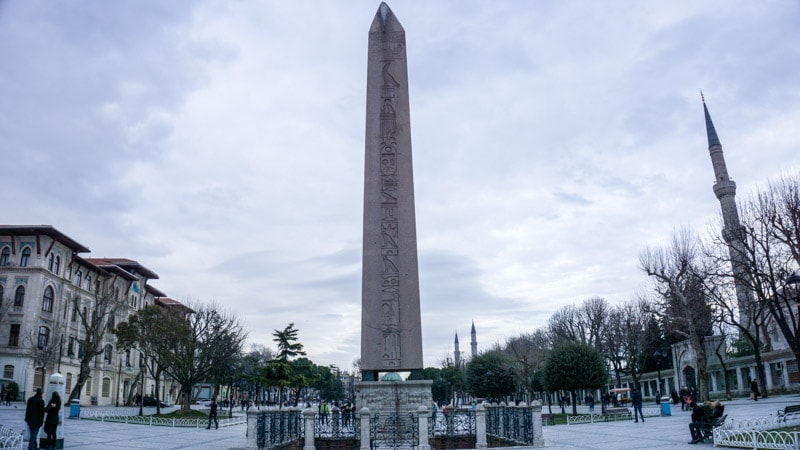
The long and narrow open space of the Hippodrome once hosted chariot races during the time of Constantinople.
Here, citizens gathered for disputes, clashes, uprisings, and executions.
The Hippodrome, dating back to the 4th century, was the site of many chariot races. Over 100,000 spectators would congregate here to cheer on their favorite chariot riders. Between races, cheerleaders, musicians, and even animals entertained the spectators.
After the chariot races ended, the square became a rock quarry. Over time, the once grand racetrack fell into ruins. When the Ottomans arrived, they used the area for horseback and archery training.
Over the years, citizens neglected the area, frequently dumping dirt from construction sites. As a result, the Hippodrome’s ground level is higher today than during the Byzantine Empire.
Walking around the Hippodrome, you will notice monuments from all over the world, including the Egyptian Obelisk, the Column of Constantine, the Column of the Serpent, and the German Fountain.
If you look closely at the base of each monument, you can see the Hippodrome’s original ground level.
This completes the historic core of the Istanbul walking tour.
Last Updated on July 24, 2024
Related Posts